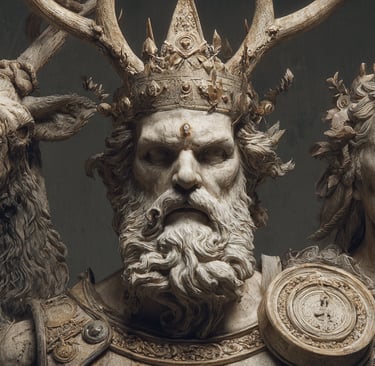Origins of Roman Religion
Roman religion didn't emerge fully formed from the Mediterranean air. Like the city of Rome itself, it developed gradually through centuries of cultural contact, political expansion, and religious experimentation. Understanding these origins reveals how a small Italian city-state created a religious system sophisticated enough to unite an empire spanning three continents.
The Agricultural Foundation
The earliest Romans were farmers, and their religious practices reflected this agricultural reality. Before there was a Jupiter or Mars as we know them, Roman religion centered on the practical needs of rural communities: ensuring good harvests, protecting livestock, and maintaining the fertility of the land.
These early religious practices featured numina - divine forces or spirits believed to inhabit natural phenomena. Unlike the anthropomorphic gods that would come later, numina were impersonal powers that required careful propitiation but didn't have human personalities, appearance, or complex mythologies. A farmer might honor the numen of a particular spring, grove, or boundary stone without imagining it had a human form or backstory.
The genius concept emerged from this early period - the idea that every person, place, and thing possessed an indwelling spirit that governed its essential character and fortune. This belief would persist throughout Roman history, even as more elaborate mythologies developed around it.
Indo-European Roots
Archaeological and linguistic evidence reveals that early Roman religious concepts shared common ancestry with other Indo-European traditions. The Romans inherited several key religious patterns from their prehistoric ancestors:
Sky Father worship appears in the early cult of Jupiter, whose name derives from the same Indo-European root as the Greek Zeus and the Sanskrit Dyaus Piter. This sky god represented divine authority, cosmic order, and the power of storms and lightning.
Sacred kingship concepts influenced how Romans understood the relationship between divine and earthly authority. Early Roman kings weren't just political leaders but also served as chief priests (pontifex maximus), responsible for maintaining the pax deorum - the peace between gods and mortals.
Household religion centered on ancestor veneration and domestic spirits reflected Indo-European patterns found from Ireland to India. The Roman Lares and Penates have counterparts in Celtic, Germanic, and Vedic traditions, suggesting ancient shared practices.
Etruscan Influences
The sophisticated Etruscan civilization profoundly shaped early Roman religious development. Living north of Rome in what is now Tuscany, the Etruscans possessed advanced knowledge of architecture, metallurgy, and religious ritual that Romans eagerly adopted and adapted.
From the Etruscans, Romans learned divination practices that became central to their religious life. Etruscan haruspices (priests who read entrails) taught Romans to interpret divine will through animal sacrifices. Etruscan augurs showed Romans how to read bird flight patterns and lightning strikes as messages from the gods.
Temple architecture followed Etruscan models, with the characteristic high podium, deep front porch, and triple cella (three-chambered sanctuary) design. The great Temple of Jupiter Optimus Maximus on the Capitoline Hill, Rome's most important religious structure, was built by Etruscan craftsmen using Etruscan architectural principles.
The Etruscan concept of sacred space influenced Roman urban planning. The ritual foundation of cities, with priests marking out sacred boundaries using specialized plows, came from Etruscan practice. This explains why Romans took boundary violations so seriously - they weren't just crossing property lines but violating sacred space.
Early Roman Pantheon
The earliest identifiable Roman deities reflect the practical concerns of an agricultural society. These gods differed significantly from their later, more elaborate forms:
Mars originally governed agriculture and fertility rather than warfare. His name connects to the Latin "mas" (male) and he was invoked to protect crops and ensure successful harvests. Only later did he become primarily associated with military conquest.
Ceres embodied the power of growing grain and was essential to community survival. Her worship involved practical rituals like offering the first fruits of harvest, reflecting the direct relationship between divine favor and human sustenance.
Terminus protected property boundaries, a crucial concern in a society where accurate land ownership meant the difference between prosperity and starvation. His worship involved rituals performed at boundary stones, reinforcing both religious and legal concepts of property.
Janus governed thresholds, beginnings, and transitions - concepts vital to agricultural communities that lived by seasonal cycles. His two faces looked both backward and forward, embodying the Roman concern with honoring the past while preparing for the future.
The Regal Period Transformations
During Rome's monarchical period (753-509 BCE), religious practices became more organized and institutionalized. Kings like Numa Pompilius were credited with establishing formal priesthoods, religious calendars, and ritual procedures that would endure throughout Roman history.
The pontifex maximus position emerged during this period, creating a chief priest who oversaw all religious activities and maintained the sacred law (ius divinum). This role combined religious authority with political power in ways that would influence Roman governance for centuries.
Religious law (fas) became distinct from human law (ius), creating parallel systems of divine and earthly justice. This distinction allowed Romans to develop sophisticated legal traditions while maintaining religious authority over moral and spiritual matters.
The Roman calendar was systematized during the regal period, with religious festivals (feriae) marking important agricultural and civic milestones throughout the year. These festivals created shared community experiences that reinforced both religious beliefs and social cohesion.
Sacred Geography
Early Romans developed a sophisticated understanding of sacred geography - the idea that certain places possessed special religious significance. This concept would prove crucial as Rome expanded beyond its original boundaries.
The seven hills of Rome each had their own religious associations and protective deities. The Capitoline Hill housed Jupiter's temple, the Palatine honored the Lares, and the Aventine became sacred to Diana and other imported deities.
Sacred groves (luci) scattered throughout Roman territory provided places for outdoor religious ceremonies and offerings. Many of these groves were associated with specific deities and maintained by local communities following ancient customs.
Water sources held particular sanctity, with springs, rivers, and lakes serving as boundaries between the human and divine worlds. The Tiber River itself was considered sacred, and its floods were interpreted as divine messages about Rome's future.
Integration and Synthesis
What distinguished early Roman religion was its remarkable capacity for integration and synthesis. Rather than rejecting foreign religious influences, Romans developed sophisticated methods for incorporating new deities and practices into their existing system.
The process of evocatio allowed Romans to invite foreign gods to abandon their original communities and accept worship in Rome, usually in exchange for military victory. This practice reflected the Roman belief that divine favor was transferable and that proper worship could win the loyalty of any deity.
Interpretatio romana involved identifying foreign deities with existing Roman gods, creating syncretic religious practices that honored both traditions while maintaining Roman religious authority. This flexibility would prove essential as Rome encounter


480-366-3550 (Domain Sales)
© SDBEST LLC, 2025. All rights reserved.
Sponsorship Disclosure
Terms of Service
